Month: July 2019
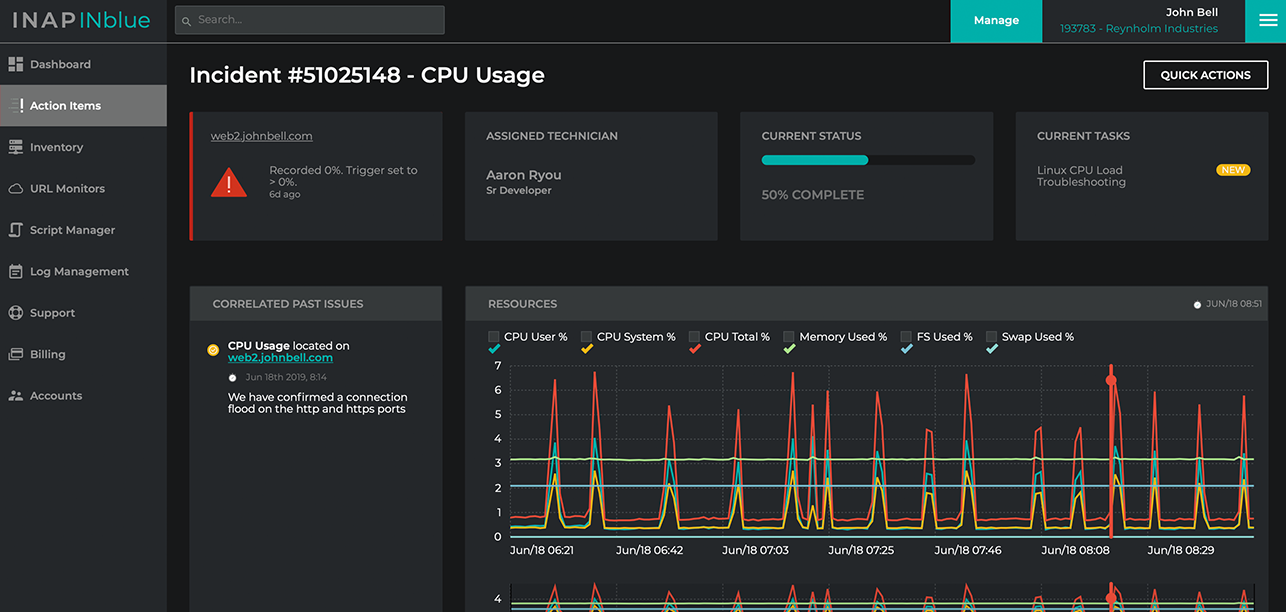
Exploring the Features of Intelligent Monitoring, Powered by INAP INblue
What would you do if you didn’t have to spend time on routine server- or cloud-related maintenance and monitoring?
According to INAP’s The State of IT infrastructure Management report, a vast majority of IT professionals say they are not spending enough time designing or implementing new solutions, working on expansions or upgrades, or focusing on information security projects. As it stands, 25 percent of participants say they spend too many hours on monitoring, and it’s clear that there’s a desire to set aside the busywork for value-added projects, allowing IT to be a center for innovation, rather than viewed as “purely keeping the lights on” by the company’s senior management.
Intelligent Monitoring, powered by INAP INblue—a multicloud infrastructure management platform, gives you time for what matters. It’s a premium managed cloud and monitoring service—available today for INAP Bare Metal customers—that raises the bar for managed hosting solutions by ensuring proactive support, service transparency and consistent performance.
“Infrastructure monitoring strategies are only as good as the actions that follow alerts,” said Jennifer Curry, SVP of Global Cloud Services at INAP. “We built Intelligent Monitoring to not only improve cloud performance and availability, but to set a new benchmark for managed services transparency.”
In addition to an improved service experience, Managed Bare Metal customers also have access to the same enterprise-grade monitoring and management tools used by INAP technicians, offering functionality and control that will eliminate the need for customers to invest in third-party remote monitoring and management solutions, including remote execution and scripting, unified log management, patch management and automation, and port, service and URL monitoring.
Let’s take a closer look at the features that make Intelligent Monitoring a one-of-a-kind solution.
Advanced Monitoring & Action Items
Built from the ground up with leading technologies like SaltStack and Elastic Beats, the Intelligent Monitoring agent tracks everything from server resource usage to Apache and MySQL connections. The in-depth, proprietary monitoring technology is installed directly onto your server, enabling INAP technicians to respond to alerts before performance degrading issues arise. Default trigger thresholds are chosen by INAP’s support team based on years of data and first-hand expertise. You have full access to all monitoring metrics and can request custom alert triggers, or modifications to trigger thresholds.
When you log into INblue, the dashboard will give you a snapshot of your server environment through system events called Action Items. If you subscribe to the fully managed Service First edition, these items allow your INAP support team to proactively manage your environment and rapidly respond to alerts. Action Items are triggered in a variety of ways, including when infrastructure or network monitoring thresholds are surpassed, when a critical service shuts down or when a new software patch becomes available.
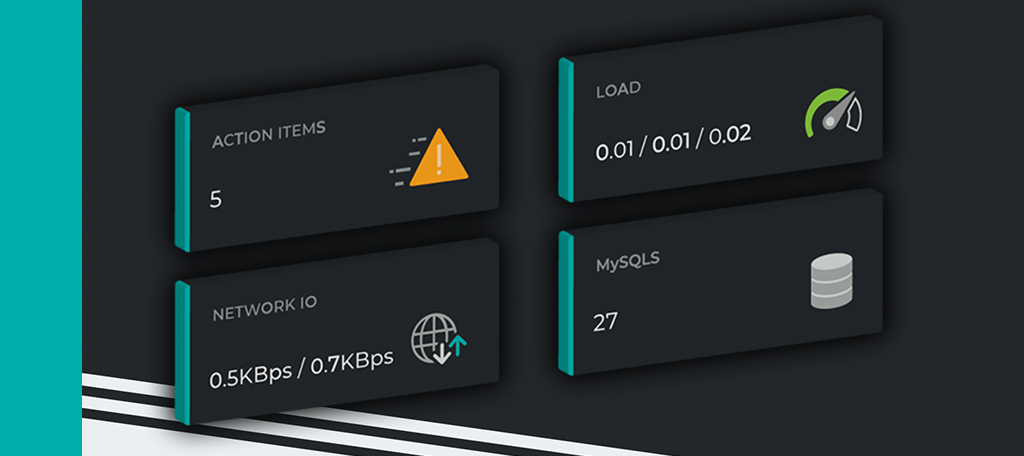
Support Remediation Aided by Smart Workflow System
INAP technicians remediate Action Items using our proprietary Smart Workflow System, which enables fast, accurate and consistent troubleshooting. Here’s a brief look how it works:
- The Smart Workflow System defines the Action Item type and initiates appropriate workflow process.
- The system automatically creates a support case for the Action Item, pulling historical correlated issue data, trigger metrics and detailed log info.
- Using the data and Action Item type, the assigned INAP Service First support technician investigates the issue following a branching series of software-defined and expert-tested remediation steps. Customers may request custom workflows for scenarios unique to their environment.
- Upon resolution of the Action Item, your assigned technician will notify you via the Action Item details page and include relevant root cause data.
- The Smart Workflow System constantly improves as new system data and insights from INAP experts modify issue definitions and remediation steps.
On the other side of the glass, the INblue platform is your vehicle for ensuring absolute transparency. At the top of any Action Item details page, you’ll see the INAP technician assigned to the workflow, the current status of the event and tasks they are currently performing or have already performed. You can review information about correlated past issues, metric and log data pinpointing a trigger, and your full support history for any Action Item.
However, for most Action Items, you won’t have to do a single thing. Intelligent Monitoring’s Smart Workflow System and the INAP Service First support team are on top of every case.
Patching and Log Management
Intelligent Monitoring radically simplifies two activities that most IT professionals consider especially tedious: patching and log management.
The patching update process is streamlined, as all available patches for your server are proactively listed in groups. You can handle this process in one of two ways, depending on how much control you want. You can confirm and schedule the patch to complete the process with INAP support, or—if you want a hands-off approach—you can choose to auto-patch your server daily and your team will receive calendar invites for each scheduled patch.
Intelligent Monitoring will also save you from manually browsing events by providing a chronological event log for all your servers. Easily filter by server and file path, or dive deep with a keyword search. You’ll be able to accelerate analysis and locate critical information. Plus, the log management feature provides your INAP technicians critical, actionable intelligence to keep your environment compliant and secure.
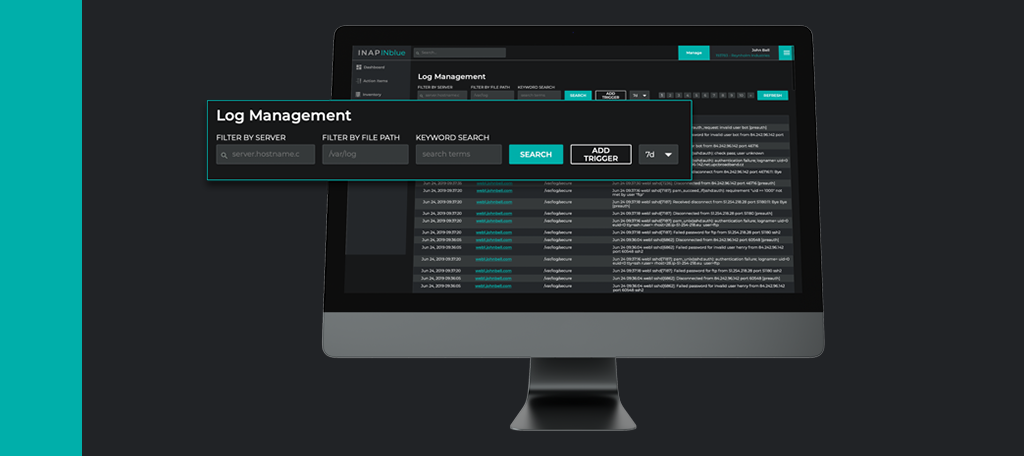
Remote Execution and Scripting
Intelligent Monitoring allows you to easily create and run remote execution scripts to any of your installed servers, giving you a single portal for taking control of your environment. You can choose from scripts you’ve already created and schedule them by inserting a token from your two-factor authentication application. You will automatically receive an email when the script successfully executes.
If you want to create your own Bash or Powershell scripts, you can do so via the Script Editor, located in the side navigation of the INblue platform.
Port, Service and URL Monitoring
Under the Ports tab on any Server Details page, you can review, edit and monitor triggers for your server’s open and closed ports. Port Status changes will be shown in your Action Items list.
Intelligent Monitoring also allows you to monitor any available services running on your system. You can also stop, start or restart services from the Services tab. For example, you can enable service monitoring on Chron Dee, enabling the auto-restart feature. With this monitoring feature enabled, you can rest assured that if a service ever fails, it will automatically create a new Action Item.
Looking Ahead
This is just the beginning for Intelligent Monitoring, powered by the INAP INblue platform. Many more features and capabilities are on the way, but in the meantime, we hope you enjoy exploring the tool and look forward to hearing your feedback.
Explore HorizonIQ
Bare Metal
LEARN MORE
Stay Connected
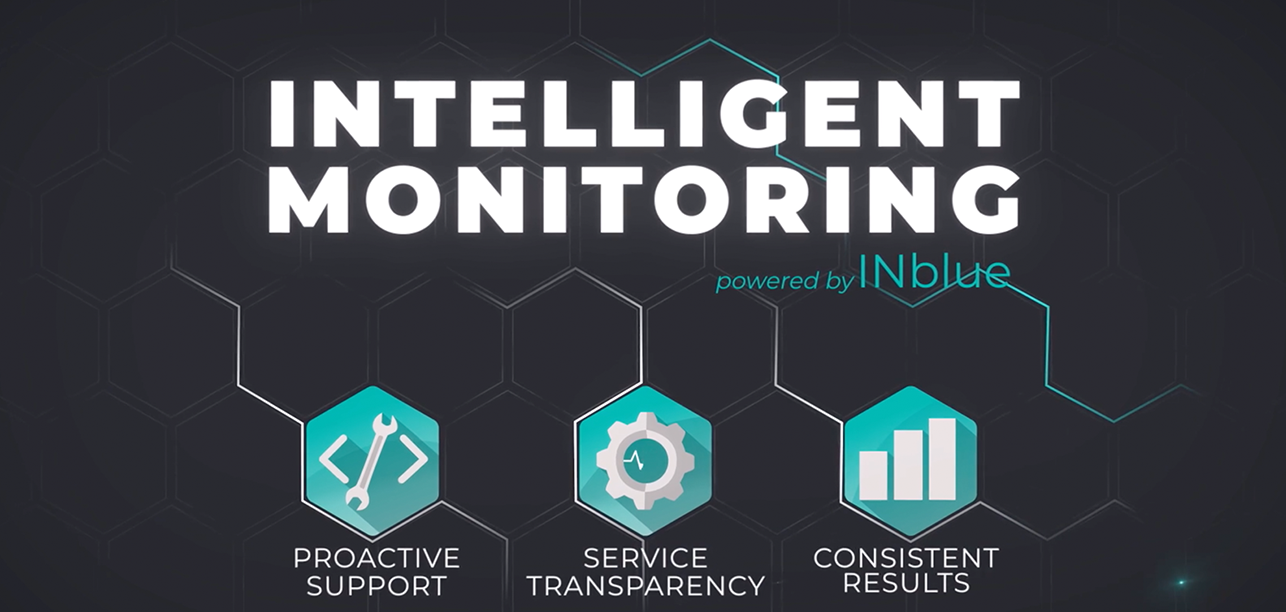
Three Reasons Why We Built Intelligent Monitoring, Powered by INblue
This week, we officially launched our premium managed cloud and monitoring service, Intelligent Monitoring. Powered by INAP’s new infrastructure and support platform, INblue, the service is an important milestone for our cloud business and one we expect to set new benchmarks for managed services transparency and support experience consistency.
You can take a closer look at Intelligent Monitoring and its many great features in the video below or over at our product page. Today, however, I’d like to share some insight into why we developed Intelligent Monitoring, and why we think it will benefit the countless businesses who rely on service providers to enable meaningful IT transformations.
1. To Retire the Concept of ‘Just Trust Us’ in Managed Hosting
We built Intelligent Monitoring because traditional managed hosting is stuck in an innovation rut.
Automation transformed data center operations. It made networks faster. It made the cloud possible by pushing the limits of scalability. But there’s one item automation hasn’t yet cracked: the disjointed, opaque experience of working with a managed service provider after the infrastructure is online.
Any managed infrastructure service inherently relies on the concept of “just trust us.” Hand over the keys to your critical infrastructure and hope the provider knows what they’re doing if something goes wrong. What too often results from this is a gauntlet of service-related pain points: reactive and inconsistent troubleshooting of regularly occurring issues, a rotating cast of anonymous technicians, unreliable response times, and the inability to see what is being done to the server or cloud environment and why.
Intelligent Monitoring acknowledges that “just trust us” is no longer acceptable. The service combines the very best elements of advanced monitoring automation with a proactive, software-defined support experience that values transparency and consistency above all else.
Here’s how it works. A lightweight and secure agent installed on your servers and VMs tracks virtually every aspect of the environment—hardware, resources, network, application metrics, available patches, open ports, etc.—in real time. If a monitoring threshold is triggered for subscribers of our managed cloud service, INAP technicians will respond to alerts before performance degrading issues arise. Tickets are created proactively, and issues are mitigated using a proprietary Smart Workflow System that assists our experts with finding accurate solutions.
Better yet, customers will immediately know who on the INAP team is assigned to a task via the event’s unique Action Item page. From this single screen, users can track progress on the open task, communicate directly with the technician and view forensic information associated with the event using logs and data from correlated past issues.
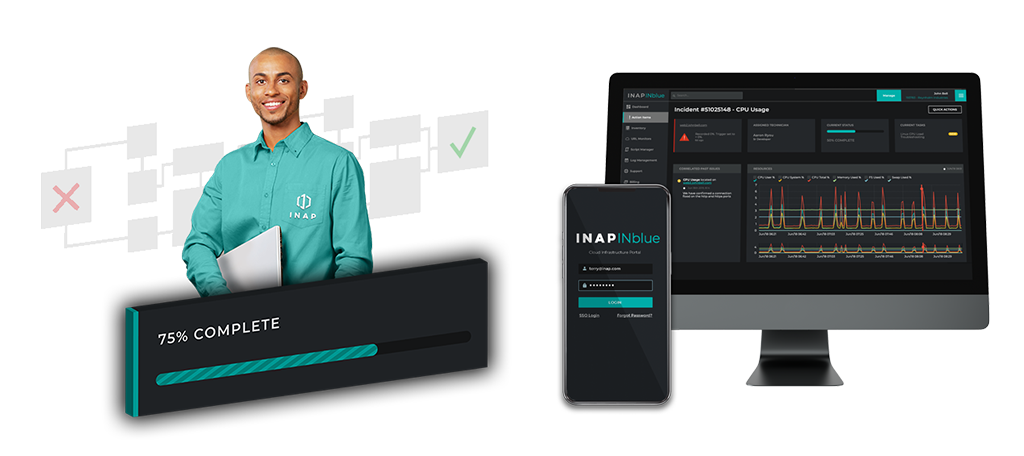
2. To Streamline the Actions That Follow Alerts
We built Intelligent Monitoring because an infrastructure management strategy is only as good as the actions that follow alerts.
While there are plenty of standalone tools available for monitoring, patching and managing remotely hosted environments, they often take a significant amount of time to configure. Certain monitoring programs are limited to read-only outputs. Meaning, admins have to manually remediate identified issues or jump to separate tools to complete the job.
Intelligent Monitoring and the INblue platform seamlessly integrate with customer server environments, allowing IT pros to not just keep tabs on the health of their infrastructure, but take control of it via a powerful toolkit that includes universal log management, patch automation, service controls, and remote execution and script management. With the INblue platform, users are also able to manage their accounts, provision new services, manage firewalls and reboot servers. By hosting with INAP, organizations will eliminate the need for many third-party tools.
With Intelligent Monitoring, fully managed cloud customers will enjoy the backing of INAP’s Service First Support team. For the do-it-yourself IT admin, we also offer the Intelligent Monitoring toolkit for a low per-server cost. To compare our Service First and Insight editions, download the product overview guide. At launch, Intelligent Monitoring is optimized for Bare Metal customers. Multicloud functionality and support is on the way in future releases.
3. To Help IT Pros Make Time for What Matters Most
Finally, the most important reason why we built Intelligent Monitoring: IT professionals want to be the centers of innovation at their organizations, but are too weighed down by time-intensive, routine infrastructure tasks to achieve that goal.
Late last year, we interviewed 500 IT professionals about time spent on infrastructure upkeep. Unsurprisingly, the No. 1 task IT professionals spend too much time on is infrastructure monitoring. Additionally, a majority of respondents (52 percent) say the time it takes their teams to address critical patches and updates leaves their organizations exposed to security risks.
While maintaining the performance and ensuring the security of infrastructure is critically important, our survey respondents acknowledged that the extent of the effort detracts from the broader mission of their job function. If hypothetically given back 16 hours of their week previously spent monitoring and troubleshooting infrastructure, IT pros said a majority of that time would be dedicated to activities like researching new tech, developing new apps and/or products, skill development and application performance optimization.
Overall, 77 percent of IT professionals agreed they could “bring more value to my organization if I spent less time on routine tasks like server monitoring and maintenance.”
We believe that Intelligent Monitoring and INAP Managed Bare Metal are just the vehicles for giving IT the time to make a truly value-added difference. I hope you’ll take a moment to see for yourself.
Explore HorizonIQ
Bare Metal
LEARN MORE
Stay Connected
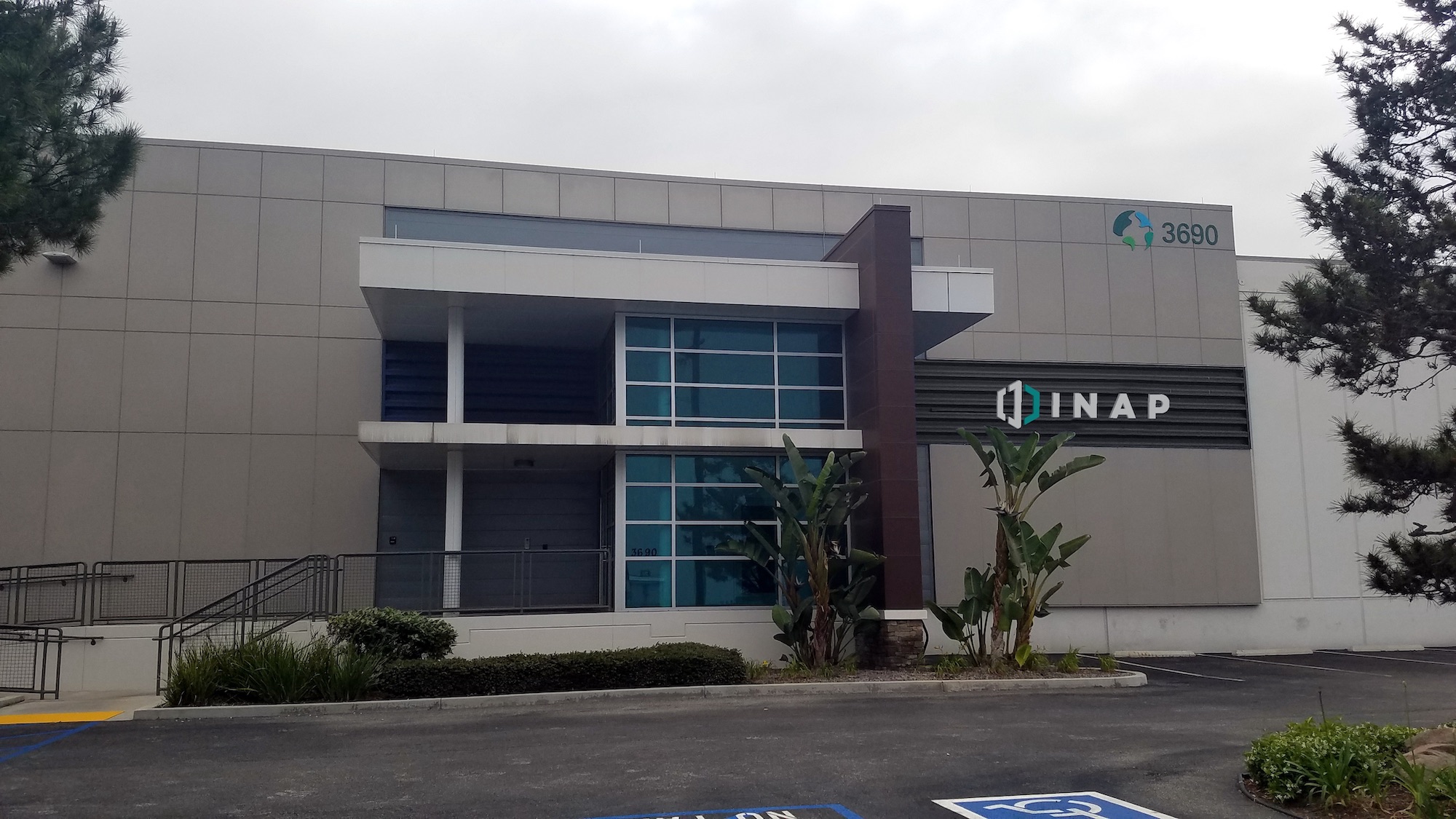
The Los Angeles data center market is in high demand. Facilities in the second-largest U.S. metro area provide important points of interconnection to data centers in Phoenix, Las Vegas and Silicon Valley, and are vital to supporting the needs of the entertainment, technology, aerospace and biomedical industries.
To manage colocation environments and reduce latency for end users, Los Angeles data center customers want to be close to their infrastructure and thus are increasingly in search of centrally located real estate. What’s more, Los Angeles is a key network gateway to Asia Pacific users, boasting some of the most interconnected internet exchange points in the world.
High demand, however, has resulted in capacity constraints. The Los Angeles data center market is seeing low vacancy rates and limited construction of new data center space, with only 9.0 MW under construction and only 6.0 MW planned at the end of 2018, according to a recent report from JLL. In comparison, nearby data center hub Phoenix saw 45.0 MW of new space, with 299.8 MW planned. Northern California saw 42.0 MW under construction over this same time period.
One reason for the limited capacity is the cost of power, partially due to older grids. In markets seeing booming data center growth, energy costs are often half of what customers will see in the Los Angeles area. However, that desire to be close to the infrastructure, as well as to key network exchanges, will be enough to drive demand for the foreseeable future.
When deploying in a competitive market like Los Angeles, enterprises must make the most of their data center investment by choosing a provider that can effectively meet unique performance needs and provide an energy efficient environment.
Considering Los Angeles colocation, network or cloud solutions? There are several reasons why we’re confident you’ll call INAP your future partner in this competitive market.
INAP Los Angeles Data Centers Deliver High-Performance, High-Efficiency Colocation and Network Solutions
INAP has six data centers and points of presence in the Los Angeles metro area, with our flagship facility located in Redondo Beach at 3690 Redondo Beach Avenue.
The 105,000 square-foot flagship Los Angeles data center is designed with Tier 3 compliant attributes and offers high-density configurations including cages, cabinets and suites. Each rack offers high power density of 20 kW or more.
INAP’s Los Angeles locations connect to Dallas, Phoenix and Silicon Valley through our high-capacity private fiber backbone. The INAP Performance IP® and Connectivity Solutions product suite provides high availability and scalable connectivity services across our global network. Customers can build the high-performance network their applications and users demand.
The flagship Los Angeles data center also includes the following features:
- Power and Space: 4 MW of utility power, 36-inch raised floor, fully integrated critical infrastructure monitoring
- Facilities: Break rooms, meeting rooms, onsite engineers with remote hands
- Energy Efficient Cooling: 300 tons of cooling capacity and N+1 with concurrent maintainability
- Security: 24/7/365 onsite staff, video surveillance, key card and biometric authentication
- Network: INAP Performance IP® and Connectivity Solutions
- Compliance: SOC 2 Type II, PCI DSS, HIPAA, Green Globes
Our recent expansion to this Los Angeles data center offers additional benefits to customers and more space in a market hungry for it.
Redondo Beach Data Center Expansion
The Los Angeles data center expansion began with a build-out of an additional 12,000 square feet of sellable space. After the build-out, the following phases will add modular infrastructure deployments contingent on customer loads. The expanded facility uses efficient mechanical design combined with an optimized UPS deployment. Total critical power capacity increased from 1.4 MW to 3.2 MW to support new customer deployments and existing customer growth.
To help address the cost of power, energy efficiency is of the utmost importance. The expansion to the Redondo Beach facility increased energy efficiency to 1.3 PEU effectiveness, a level above the national average of 1.67.
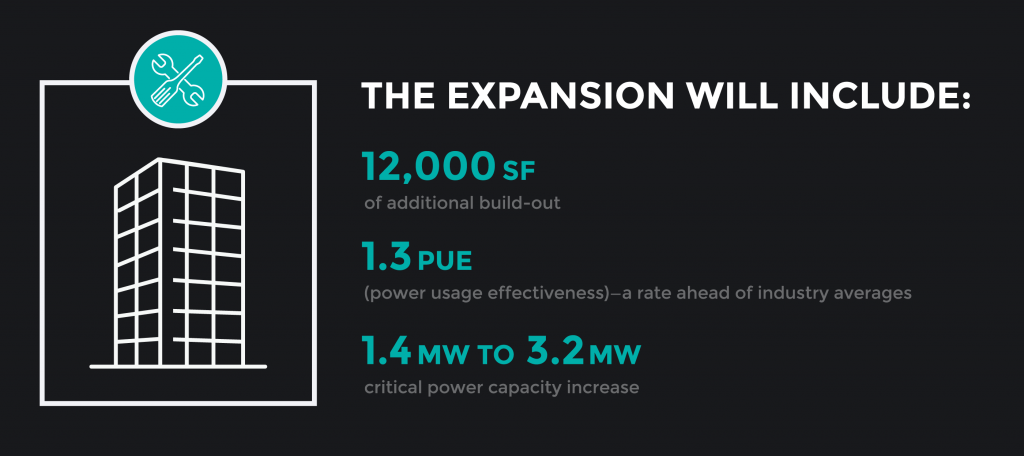
Spend Portability Meets Changing User Demands
Organizations need the ability to be agile as their needs change. With INAP Interchange, there’s no need to worry about getting locked into a long-term infrastructure solution that might not be the right fit years down the road.
There are a variety of business cases for Interchange, including a move from a colocation facility to a bare metal or private cloud environment, or a re-deploy of applications to a new hosted environment. Geographic flexibility is a common reason for a tactical shift. For example, a company based in an INAP data center in Los Angeles may see an increase in demand in its SaaS solution in the Southeastern U.S. To be closer to its customers, the company can shift to a custom-engineered solution in one of INAP’s two Flagship data centers in Atlanta.
Colocation, Bare Metal and Private Cloud solutions are eligible for Interchange. The program allows customers to exchange infrastructure environments a year (or later) into their contract so that they can focus on current-state IT needs while knowing they will be able to adapt for future-state realities.
You can learn more about the INAP Interchange by downloading the FAQ.
Our Los Angeles data centers are conveniently located in the L.A. area:
- Flagship Los Angeles Data Center
3690 Redondo Beach Avenue
Redondo Beach, CA 90278 - Los Angeles Data Center
2260 E El Segundo Blvd
El Segundo, CA 90245 - Downtown Los Angeles POP
818 7th Street
Los Angeles, CA 92118 - Downtown Los Angeles POP
624 S Grand Avenue
Los Angeles, CA 90017 - Downtown Los Angeles POP
600 W 7th Street
Los Angeles, CA 90017 - Downtown Los Angeles POP
1 Wilshire Blvd
Los Angeles, CA 90017 - Downtown Los Angeles POP
1920 E Maple Avenue
El Segundo, CA 90245
More About Our Flagship Los Angeles Data Center
Our flagship Los Angeles data center is located at 23690 Redondo Beach Avenue, Redondo Beach, California. This Los Angeles colocation data center connects to Phoenix, Dallas and the Silicon Valley data centers via our reliable, high-performing backbone. Our carrier-neutral, SOC 2 Type II Los Angeles data center market facilities are concurrently maintainable, energy efficient and support high-power density environments of 20+ kW per rack. If you need Los Angeles colocation services, or other data center solutions in the Los Angeles area, contact us.
Explore HorizonIQ
Bare Metal
LEARN MORE
Stay Connected

Sovrn Advances Digital Advertising with Engagement-Focused Tech
In 2019, advertising will officially reach a milestone a long time in the making: Digital spend will surpass spend in traditional channels for the first time in history, with projected totals reaching $129 billion and $109 billion, respectively.1
This massive growth in digital advertising has given rise to a new host of technology companies dedicated to maximizing value to both advertisers and content publishers. But what if the key to that equation is a renewed focus on the experience of an important third party—the actual viewers consuming the ads?
Enter INAP customer, Sovrn.

Sovrn provides innovative advertising tools, technologies and services to help independent publishers grow their audiences and make money through engaging ad content. The company carefully develops its technology to best serve its customers, including the agencies and brands who participate in the ad exchange.
A customer since 2017, Sovrn continues to grow their relationship with INAP, recently announcing a new cloud hosting agreement that will add performance-driven bare metal solutions in Seattle and Ashburn. The scalable single-tenant infrastructure platform includes INAP’s route-optimized Performance IP® service, which automatically directs Sovrn’s traffic along the lowest-latency path—a critical benefit in an industry where milliseconds matter.
I met with Sovrn’s Chief Technology Officer, Jesse Demmel, to learn more about their //Signal product, why it’s different, and the elements of their data center and network strategy that keep their business growing.
This interview has been lightly edited for clarity and length.
Ryan: With products like //Signal, it seems as if you’re trying to deliver a mutually beneficial experience for publishers, advertisers and content consumers. How does Sovrn’s technology achieve that?
Jesse: I’m glad you picked up on that. //Signal is trying to deliver for all three, which is the perfect trifecta. When you go to a website and you’re highly engaged, you’re spending a lot of time there. Currently, the best way a publisher can make money is to shove as many ads as they can in front of a consumer, because it’s an impression-based economy. However, those values are not aligned with what a consumer values, which is engaging content. What //Signal attempts to do is capture all those engagement metrics from a reader on a website, or on a piece of content, and make those valuable to the advertiser. And then, rather than using a currency of impressions and cost per impression, perhaps we can soon get to a place where we’re using cost by time or engagement value.
In short, the advertisers get more value with this model because they’re seeking conversion in highly engaged readers. The publishers end up getting paid more for that as well, because they’ve written content that is engaging. And then the readers get better value because they’re getting fewer, more engaging ads that entice them to act.
From the user’s perspective, when they’re on a website using your technology, do you think they consciously notice that the ads are more engaging and less abrasive?
The goal of the product is for consumers not to consciously notice it. Consumers have come out and said that they want free content on the web, and that they like advertising that is relevant and targeted to them. What they don’t like is advertising that interferes with their experiences. They’re trying to enjoy the content. The idea of //Signal is being able to reward publishers on their ability to create engaging content and serve consumers with less intrusive advertising. The ads are more meaningful and interfere less with their actual web experience.
With any media-rich website, speed is key to driving visitor engagement. How do publishers that rely on ad revenue ensure their tools aren’t getting in the way?
Latency is important to our publishers and their pages, and with modern browsers and web architectures, there are multiple ways to manage latency. A long time ago, everything that loaded was included in that latency. But now you can serve the important parts of the page first and things that aren’t as important can load secondary to that. Our publishers work hard to make sure that the webpage architecture doesn’t adversely affect the reader experience, and our technology tries to help with that.
What will be different about the ad tech industry five years from now?
I hope that ad tech will evolve to be more aligned with the engagement that’s happening on the web, rather than the gross number of impressions. Internal to the ad tech industry, I hope that the movement for greater transparency continues to change.
I think the biggest change facing the ad tech industry is consumer privacy, so the death of the third-party cookie. Safari keeps clamping down on their restrictions, and now Chrome is entering the fray with better controls around third-party cookies. Mozilla is doing the same thing with Firefox, so I think there’s a greater awareness that consumer privacy is going to be at the forefront, which we totally welcome and want to help drive. I think consumers are going to start owning their data decisions, and they’re going to decide who has access to their data and for which purposes. The ad tech industry will be coming along for that ride to play nicely in that environment.
I’m curious about the backend of how your technology is brought to life. Can you summarize your IT infrastructure strategy for delivering Sovrn’s products and services?
The ad tech industry, delivering tools for our publishers, that ecosystem is extremely dynamic and changes frequently. It moves very, very fast. We are solving internet-scale problems that change as fast as innovation happens on the internet, so we must be able to migrate extremely large workloads to work properly for ever-evolving standards. Our IT infrastructure must be flexible in nature, highly scalable and component based to allow us to easily add on to the technology. From a team perspective, that means we’re as agile as possible, getting tight feedback loops with our customers so that we’re always building what they want while making small adjustments along the way.
How has that approach evolved since the company was founded?
That agile mentality hasn’t changed since the company’s founding. But one way we’ve evolved is with a push to make sure the customer is at the center of everything we’re building. We’re solving such challenging technical problems, and I think it’s easy for the engineering teams to get caught up and forget who they’re solving these problems for. There’s actually a customer on the other side, and we’ve worked very hard over the last few years to make sure they are the focus.
What are some of the information technology benchmarks you set to determine if you’re successfully running the platform?
The values that we measure are performance-based for our publishers across our different products. Ultimately, it’s about whether they are making money from the ad exchange.
For performance, what’s going to drive that? It’s an extremely low-latent environment, so we make sure that timeouts occur as infrequently as possible. That’s one benchmark that we’re constantly monitoring. We also look at availability and reliability of the systems. Uptime is extremely critical with billions and billions of requests going through the system every day. Every millisecond or second that the system goes down is going to cost our publishers money, so that availability is extremely important.
Scalability is obviously a big one when we’re dealing with the amount of traffic that we are, and our traffic patterns follow consumer internet trends. In a given region for a given day, our traffic might go up and down by as much as 100 percent. Across all those requests, being able to scale that infrastructure up and down to meet those needs is extremely important. And then, we operate with a ton of data, so making sure that the data is stored and always reliable, as well as available and redundant, is very important. Security is obviously important as well.
Those are the kind of things we think about when we run the platform.
How does INAP, or your IT infrastructure, help achieve that availability, scalability, low latency and redundancy?
INAP was a selection for us primarily in helping with the low latency and availability piece, making sure the systems are always up and available. INAP is great in terms of networking performance, which is extremely critical to our business. Second is the service component. A server is always going to break down, network routes are always going to get messed up. How responsive and how proactive of a partner do we have in helping us resolve those issues? INAP customer service has proven very easy to work with.
—
1. Data featured in Ad Week, “U.S. Digital Ad Spend Will Surpass Offline in 2019”, Feb. 20 2019










